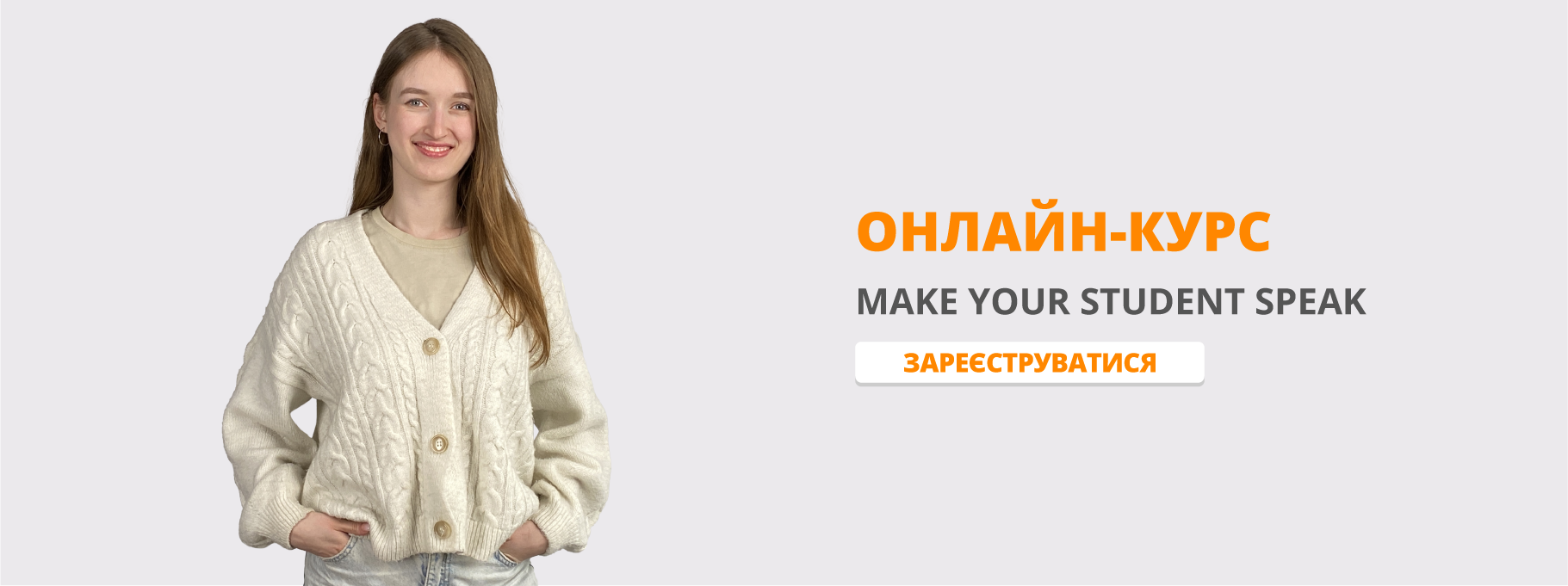«Конспект уроку з англійської мови для 8 класу на тему "Подорож до бібліотеки". Урок-подорож з елементами мультимедійних технологій, презентацій проектних робіт учнів»
Конспект уроку з англійської мови для 8 класу на тему "Подорож до бібліотеки" - це нестандартний урок-подорож з елементами мультимедійних технологій, презентацій проектних робіт учнів. Матеріали уроку можуть бути використані вчителями, які викладають англійську мову за за будь-яким підручником. Тема за програмою - "Література".
Тема. Подорож до бібліотеки
Мета: навчальна: удосконалювати мовленнєву, мовну та соціокультурну компетенції учнів: повторити й активізувати лексичні одиниці з теми, вчити висловлювати свої думки, працювати з тестами, практикувати вживання пасивного стану дієслів.
розвивальна: розвивати пізнавальну активність, вчити аналізувати й узагальнювати матеріал, розвивати навички співробітництва. виховна: розширювати кругозір дітей, прищеплювати любов до книжок та до читання, виховувати зацікавленість у розширенні своїх знань.
Тип уроку: урок-подорож з елементами мультимедійних технологій, презентацій проектних робіт учнів у 8 класі (тема за прорамою - «Література»)
Обладнання: презентація уроку в Power Point, текст для читання «Libraries», картки з завданням для індивідуальної та парної роботи, малюнки (фото бібліотек) та назви кімнат бібліотеки, презентація про найкрасивіші бібліотеки світу, презентації проектів учнів про письменників, мультимедійна дошка, комп’ютер.
ХІД УРОКУ
І. ЕТАП ОРІЄНТАЦІЇ ТА ПОВІДОМЛЕННЯ ТЕМИ, МЕТИ УРОКУ
1. Привітання.
Т: Good morning everyone! Nice to see you!
Ps: Nice to see you too!
Т: Today we have unusual demonstrative lesson. And our guests are the teachers from different schools. Let’s greet our guests.
Ps: Good morning, dear teachers!
Good morning! How are you?
We are very happy
To say “Hello” to you!
2. Повідомлення теми та мети уроку.
Т: I'm sure our lesson will be successful and our work will be productive.
T: Now read the riddles and guess the theme of our lesson. (Слайд 1)
The field is white,
Black is the seed,
The man who sows it,
Is clever indeed.
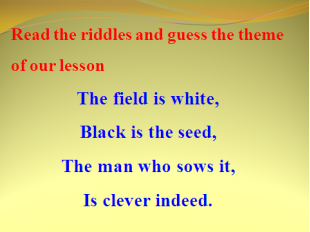
P: These friends are books.
T: Right you are. A book is a main source of knowledge. It is impossible to imagine our life without books. They play an important role in educating, upbringing and help us to get useful information. Where can we get books?
P1: In the bookstores.
P2: At the markets.
P3: In the libraries.
T: So the theme of our lesson is "A trip to the library". Let’s write it on the classboard. (Слайд 2)
|
A
|
|
T |
R |
I |
P |
|
T |
O |
|
T |
H |
E |
|
L |
I |
B |
R |
A |
R |
Y |
(Діти пишуть назву уроку в клітини на дошці, потім перевіряється правильність написання)
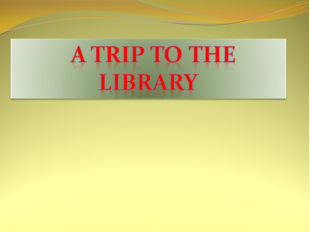
At the lesson we are going to revise the words learned earlier, to improve your reading, listening and speaking skills, revise Grammar: the Passive Voice.
3. Уведення в іншомовну атмосферу.
Мовна зарядка
T: Now, read these proverbs and say how you understand them. Do you agree with them? (“Microphone”) (Слайд 3)
• The more you read the more you know.
• A good book is a source of wisdom.
(Учні по черзі висловлюють своє ставлення до книги та читання.)

Т: As I have said our lesson is unusual. We’ll travel around different rooms of our imaginary library and find interesting tasks there. As our library is unusual the rooms will be unusual too. Let’s look at the map/plan of our trip and read the names of our library’s rooms.
(на дошці карта уявної подорожі, учні читають назви по черзі)
II. ЕТАП ОРГАНІЗАЦІЇ НАВЧАЛЬНОЇ ДІЯЛЬНОСТІ УЧНІВ
Room 1. “The registration Desk” (Слайд 4)
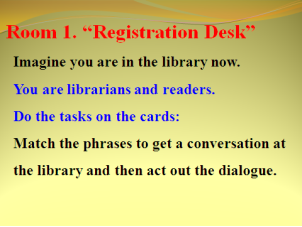
Т: Imagine you are in the library now.
You are librarians and readers. Do your tasks.
Match the phrases to get a conversation at the library and then act out the dialogue. (таблиця з діалогом подана на картках, діти працюють в парах складають діалог, потім в парах розігрують його)
|
1. Hello! We've just moved into this district and I'd like to borrow books from your library. |
a. Please fill in this form. Write your name and address. |
|
2. No, not yet. |
b. Ten days. If you need some books for a longer period you can renew them. You can do it to by telephone. You needn't specially come to the library for that. |
|
3. How many books can I borrow at a time? |
с Three fiction books and four non-fiction |
|
4. How long can I keep the book? |
d. Good. Have you got a library card? |
|
5. Thank you. Do you have «Harry Potter and Philosopher Stone» by Joanne Rowling. I am interested in fantasy and adventure novels. |
e. Look through the catalogues. Our library is rich and I sure you'll find the books you need. |
|
6. Thank you. |
|
Key : 1-d, 2-a, 3-c, 4-c, 5-e, 6.
Room 2. “Reаding Room” (Слайд 5)
1) Етап підготовки до читання
T: Answer the question.
1. Do you sometimes borrow books from a library? 2. What do you call a person who works in a library? 3. What kind of books can you find in the library? (adventure books, novels ? plaea, detective stories, science fiction, biographies, history books) 4. Do you know the origin of the word “library”?
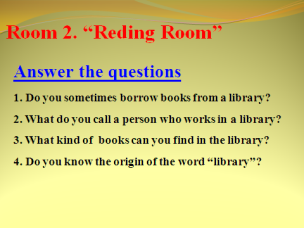
T: Listen and repeat (Слайд 6)
• Egypt
• Alexandria [ælig’zα:ndriə]
• Assyria [ə’siriə]
• BC
• Papyrus [pə’paiərəs]
• Ptolemy I
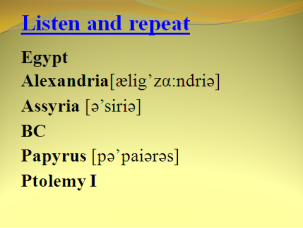
2) Етап читання
LIBRARIES
The word “library” comes from the Latin word “libra”, meaning “book”.
This is a place where information in print (books, manuscripts, periodicals and musical scores) and in other forms is collected and arranged to serve people of all ages and interests.
Libraries appeared in ancient times in Egypt, Assyria ([ə’siriə]), Greece and Rome.
Perhaps the most famous library of that early age was at Alexandria ([ælig’zα:ndriə]). It was found by Ptolomy I. By the middle оf the first century B.C. there were 700,000 papyrus ([pə’paiərəs]) rolls in the library.
The library today is the centre for all kinds of communications: printed, pictured, recorded, and even electronically stored. People go to the library to read, look, listen, search, relax, discuss, learn, and think.
Libraries can be found in many places. There are libraries in small towns and large cities, and there are libraries in schools, universities, colleges.
The largest and the best known libraries in the world are: the British National Library in London, the Library of Congress in Washington and Russian
The national libraries of different countries keep in touch and exchange books and information.
Central scientific Library is the largest one in Ukraine.
It was founded in 1919 as the Ukrainian National Library. By 1940, its Collection numbered about 5,000,000 books.
Today the Central scientific Library in Kyiv has got 10,000,000 books, and contains the richest соllection of old Ukrainian books.
In addition, there are 350,000 manuscripts from the 15-18 centuries, 175,000 musical pieces, 177,000 reproductions.
Libraries are a real wealth of any country.
3) Етап перевірки розуміння змісту тексту
T: True or false. (Слайд 7)
1. A library is a place where information in print and in other forms is collected.
2. Libraries appeared in ancient times.
3. There were 700 papyrus rolls in the library at Alexandria.
4. Central Scientific Library is the largest one in Ukraine.
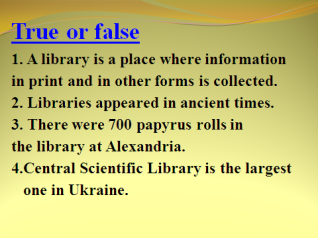
T: Answer the questions. (Слайд 8)
1. Does the word library come from the Latin or Greek word?
- Where did the first libraries appear?
3. By whom was the library in Alexandria found?
4. Where can libraries be found?
5. Why do people go to the library?
6. What are the famous libraries in the world?
- What is the largest library in Ukraine?
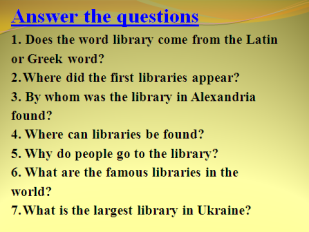
Room 3. “The Grammar Room” (Слайд 9)
Grammar. The using of the Passive Voice
S + to be + Ved(3)…
T: And now let’s recall the formation of the Passive Voice as I want you to use it while speaking about well-known books and their authors.
(Демонстрація презентації. Діти повторюють правило утворення пасивного стану, виконують тести, подані на слайді.)
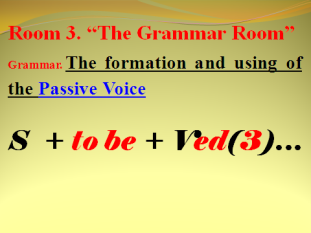
T: Choose the correct variant. (Слайд 10 та на картках)
1. This house ... by my grandpa in 1890.
a) is built
b) was built
c) will be built
2. The letter ... tomorrow.
a) is sent
b) are sent
c) will be sent
3. What ... in each of these regions.
a) are grown
b) is grown
c) grows
3. A new film ... yesterday.
a) was shown
b) is shown
с) are shown
5. I ... about it every week.
- was told
- b) were told
c) am told
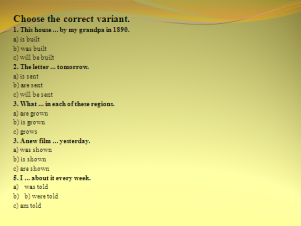
T: Game «Find the Writer». Connect the names of writers with the names of their books and say who the following books were written by. Use the Passive Voice. You work in pairs.
(Роздати учням картки для парної роботи. На картках позначено ім'я письменника або назву літературного твору. Учні повинні знайти відповідностиі між назвою твору та ім'ям письменника на картці. Потім вони повідомляють в пасивному стані хто який твір написав).
1 пара учнів
|
Joanne Rowling |
Daniel Defoe |
Charles Dickens |
William Shakespeare |
|
“Harry Potter and the Philosopher’s Stone” |
“Robinson Crusoe” |
“Oliver Twist” |
“Romeo and Juliet” |
2 пара учнів
|
Rudyard Kipling |
Mark Twain |
Arthur Conan Doyle |
Robert Louis Stevenson |
|
“The Jungle Book” |
“The Adventures of Tom Sawyer” |
“The Adventures of Sherlock Holmes” |
“Treasure Island” |
Room 4. Relaxation Room (Перегляд фільму-презентації про найкрасивіші бібліотеки світу та повідомлення після перегляду, що було найцікавішим та новим)
Т: Let’s have a rest and watch the film about the most beautiful libraries of the world, after watching this film you’ll say what was the most interesting and new for you.

Room 5. “The Project Room” (Слайд 12)
Т: Some of you have the task to prepare the projects about one of the British writers. Let’s listen at your presentations. Учні презентують свої проекти про письменників (презентації).
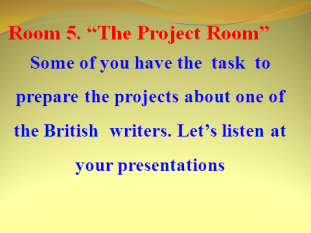
III. ЕТАП КОНТРОЛЬНО-ОЦІНЮЮЧИЙ
Room 6. “Self-assesmant Room” (Слайд 13)
(Учні знаходять в портфоліо “Self-assessmant graph” з теми «School Library»та роблять самоооціювння своєї роботи на уроці, повідомляють чого досягли на уроці)
1. Підведення підсумків уроку.
Бесіда в режимі T—>P1—>P2—>P3.
Т: Well, our lesson is coming to the end. You’ve done a great job. So, can you tell me what you have learnt today? ”
Let’s sum up the results of our work:
• I know...
• I can...
• I’ve learned...
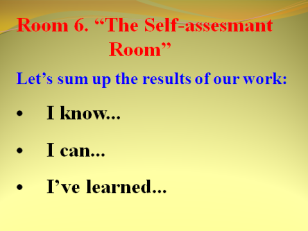
2. Домашнє завдання
Т: Your homework is to write a short essay «My impressions of the last English lesson». (Слайд 14)
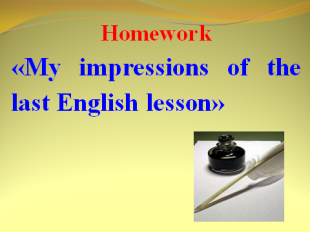
Т: I’m pleased with your work. Well done! Thank you for your excellent work and I give you the following marks … to … .
I want you to remember: (Слайд 15)
“Read books!
And you will love
this amazing world!”.

T: The lesson is over. I wish you good luck! You may be free for today. Good-bye!
1
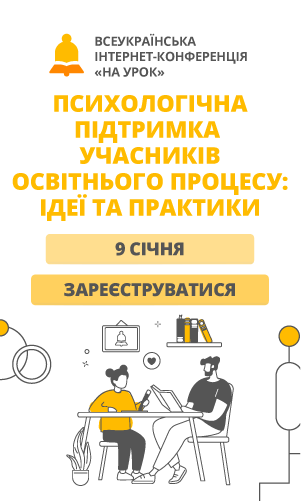

про публікацію авторської розробки
Додати розробку
